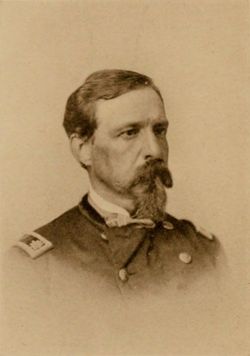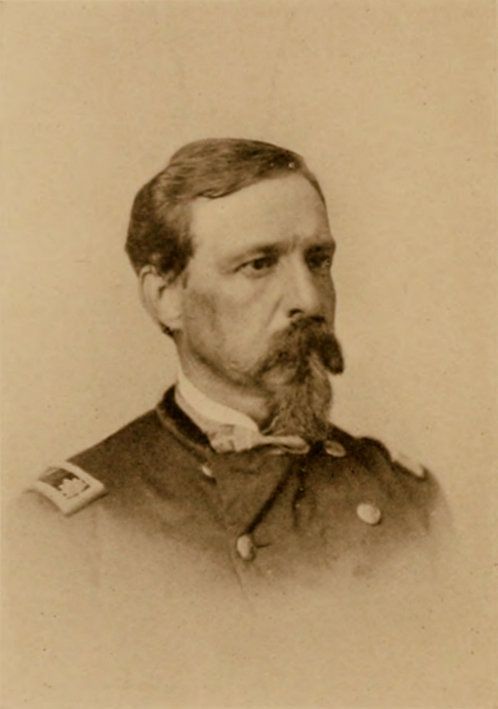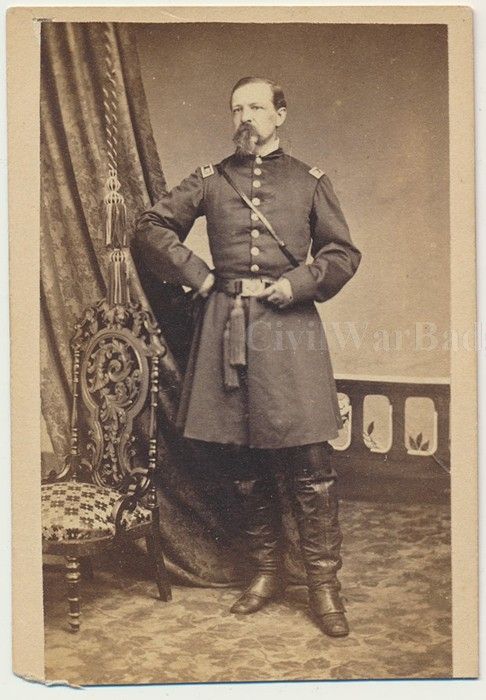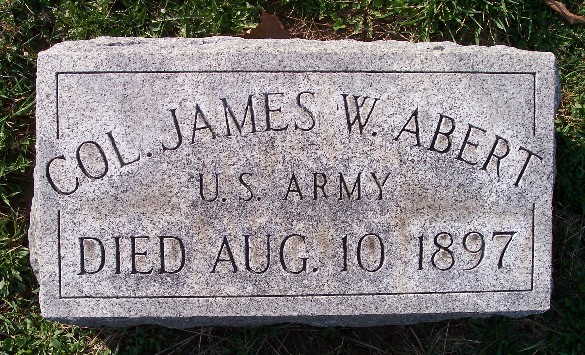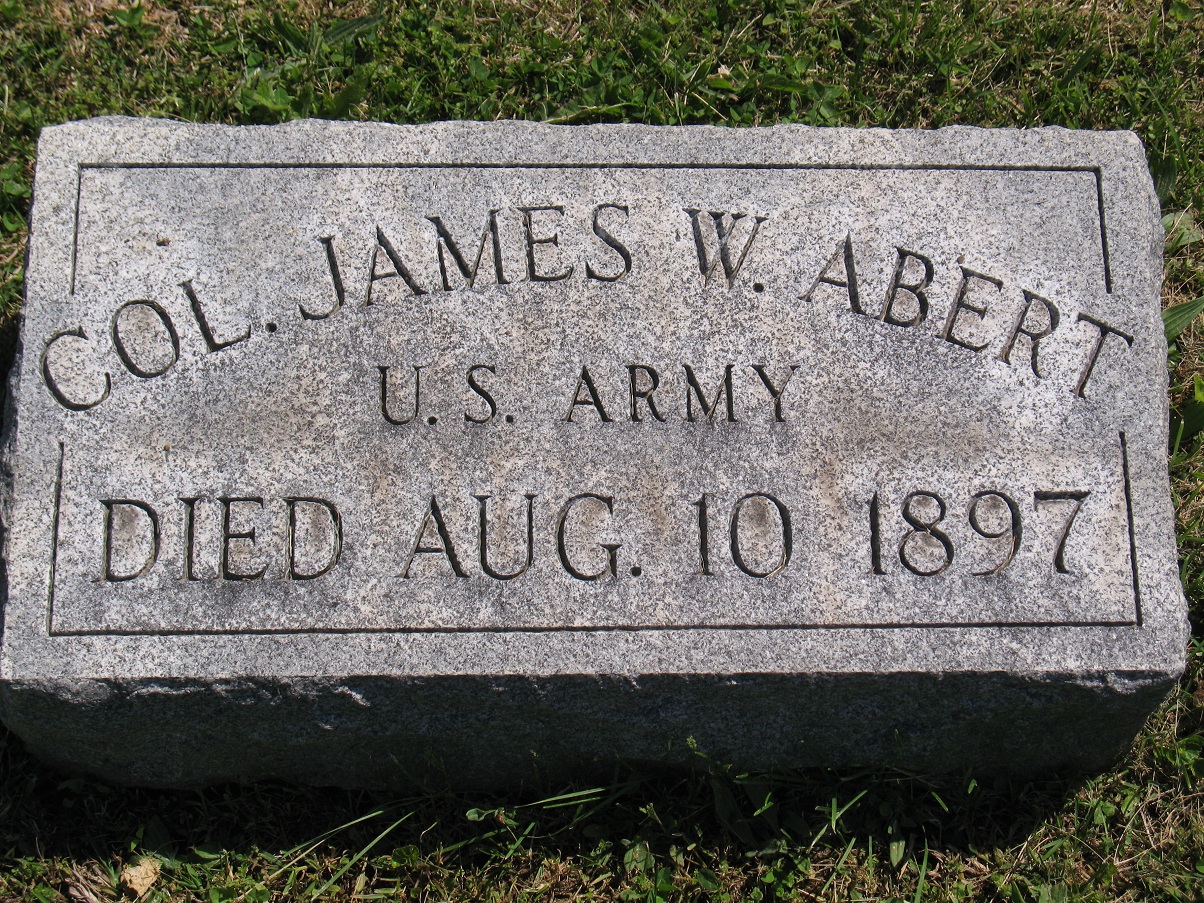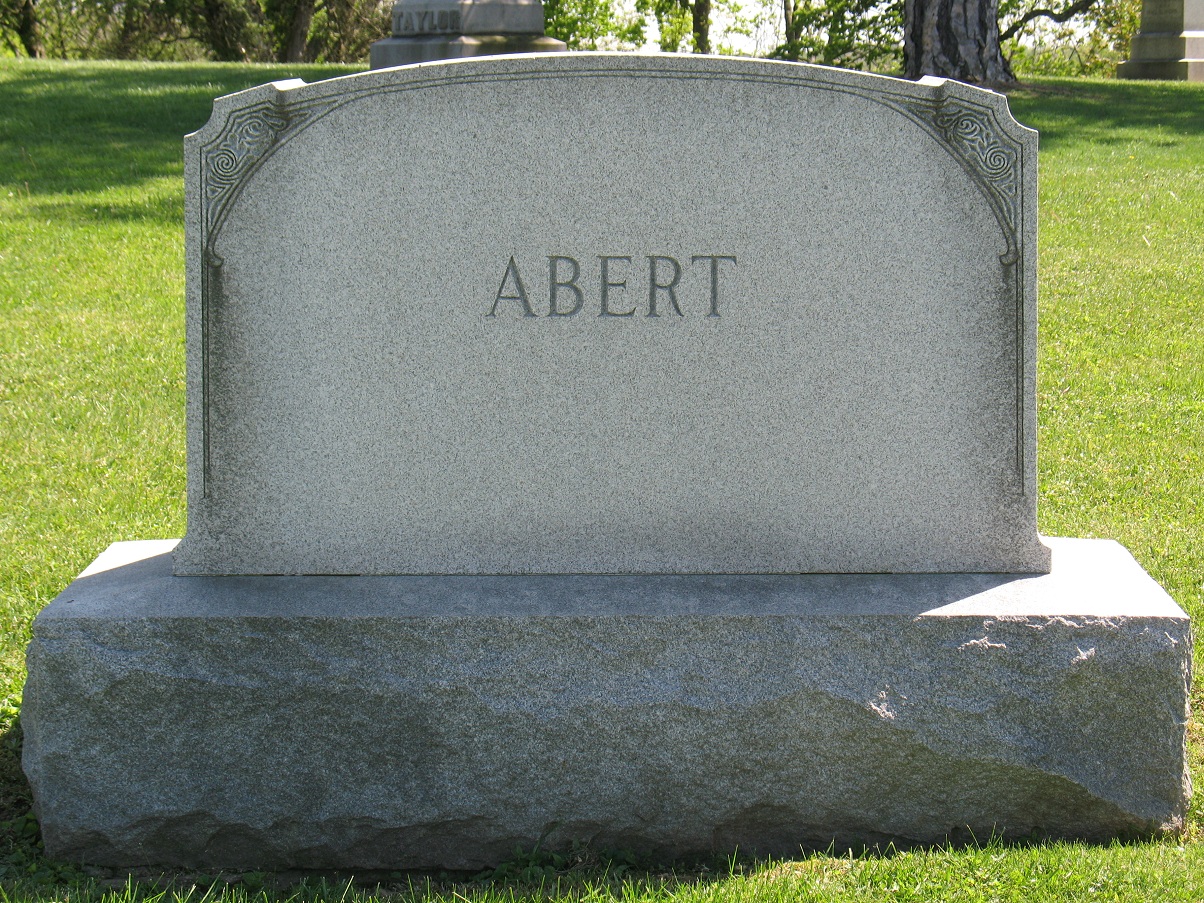James William Abert, army officer and explorer, was born on November 18, 1820, in Mount Holly, New Jersey, the son of Maj. John James Abert, the Chief of the Bureau of Topographical Engineers. In his teens he attended Princeton University, where he graduated, probably from its academy, in 1838; he entered the United States Military Academy at West Point in September of that year. In 1842 he was assigned to the Fifth United States Infantry. After an uneventful year of garrison duty in Detroit, Abert was transferred to the Corps of Topographical Engineers in May 1843. His first assignment in the corps was that of assistant topographical engineer in an extensive survey of the northern lakes, 1843-44. During that time he married Jane Stone, and they had a son.
In the summer of 1845 Abert was attached to the third expedition of John Charles Frémont, whose assignment was "to makeBent's Fort reconnaissance southward and eastward along the Canadian River through the country of Kiowa and Comanche." Frémont, however, chose to take his main party on to California, and gave command of the Canadian River mission to Abert, with an assistant, Lt. William G. Peck. The legendary mountain man Thomas Fitzpatrick was employed as a guide, and Bent employees John L. Hatcher and Caleb Greenwood were hired temporarily as hunters. Except for the two young officers, the entire party of thirty-three was composed of civilians.
The expedition struck the headwaters of the Canadian and followed it through the breaks in eastern New Mexico and into the Texas Panhandle. Continuing along the north bank of the Canadian, Abert noted many Panhandle landmarks, including Atascosa Creek and the Alibates Flint Quarries, which he labeled Agate Bluffs. The expedition arrived at Bent's trading house in what is now Hutchinson County on September 14, rested there for a day, and exchanged gifts with a party of Kiowas and Comancheros. Three Kiowas had briefly joined the expedition to help keep the peace. On September 16, after Hatcher and Greenwood had left to return to Bent's Fort, the remainder of Abert's party crossed the Canadian and turned toward the southeast. Near the site of present Laketon, in Gray County, the party struck the North Fork of the Red River, which they mistook for the Washita and followed for a while, then turned back northeast toward the Canadian. They crossed the present Oklahoma boundary before reaching the Canadian, which they followed to its confluence with the Arkansas. At Fort Gibson, in eastern Indian Territory, the expedition was disbanded, and Abert and Peck went on to St. Louis.
In his report Abert described in detail the geology, flora, and fauna of the Canadian valley. His maps of the region were the most accurate of the time, and later explorers found them quite useful, especially for finding campsites and watering places. The abundance of wild game in the valley had kept the expedition well supplied with food. Abert's description of the habits and customs of the Kiowa and Comanche Indians proved valuable to the federal government later. Along with his maps and written accounts, Abert made several sketches and watercolors of activities at Bent's Fort, native animals, and outstanding Indian personalities, including the Kiowa chief Dohäsan, whose village the expedition had visited on September 17.
In the summer of 1846 Abert and Peck accompanied Gen. Stephen W. Kearny's Army of the West to New Mexico. Abert came down with a fever in July and had to remain behind at Bent's Fort to recuperate. While he was sick he continued his studies in natural science and ethnology and compiled a tribal dictionary. Afterward he joined Peck in Santa Fe, and the two lieutenants conducted a thorough survey of New Mexico as far south as Socorro. They visited each of the Rio Grande pueblos and, as before, took note of the geology and wildlife of the new American territory, as well as of the habits and customs of its native residents. Abert then went to Washington to submit his report to Congress. From 1848 to 1850 he served on the faculty at West Point, where he taught drawing. He was promoted to first lieutenant in 1853 and to captain in 1856. After the death of his first wife he married Lucy Taylor, with whom he had several children. In 1860, after serving two years in Florida, he traveled in Europe to study military affairs and visit various forts and arsenals. When the Civil War broke out Abert served in the Shenandoah valley from June 1861 to September 1862. James William Abert
D. H. Strother, a well-known writer for Harpers Gazette, was on Abert's staff. He tells this story of his boss: "As night advanced the rain became heavier, and no baggage train. The chiefs spread their shawls and blankets beneath the apple-trees, and prepared to pass the night en bivouac. My Captain, who was an old Rocky Mountain campaigner, made it a rule "never to go hungry if he could get a meal, and never to sleep in the rain if he could find a dry spot." So we bethought ourselves of a deserted log-house which stood, like an eyeless skull, in an adjoining field. Leaving our horses picketed up to their bellies in oats, we shouldered our saddles and took possession of our discovery. There were neither doors nor windows, but the roof and flooring were sound, and we soon had a fire roaring in the mouldy chimney."
On March 3, 1863, when the Corps of Topographical Engineers and the Corps of Engineers were reunited, he was promoted to major. He was later severely injured by a fall from his horse, and in 1864 he resigned from the army. He had been brevetted lieutenant colonel for his "faithful and meritorious service." During the next five years, Abert and his family engaged in the mercantile business in Cincinnati, Ohio. From 1869 to 1871 he served as examiner of patents in Washington. He taught English literature at the University of Missouri from 1877 to 1879 and afterward was president of the Examining Board of Teachers of Public Schools in Kentucky. Abert was reappointed a major in the United States Army on January 14, 1895, and retired almost immediately. He died at his home in Newport, Kentucky, on August 10, 1897.
Despite the value of Abert's western frontier journals, they lay almost forgotten in government files until 1941, when H. Bailey Carroll first published the 1845 report in the Panhandle-Plains Historical Review. William A. Keleher published Abert's New Mexico report in 1962. In 1967 and 1970 special publications of the Abert journals were edited under the title Through the Country of the Comanche Indians in the Fall of the Year 1845 by John Galvin, a California historian. They featured illustrations of Abert's watercolors, many of which were obtained from his descendants. A species of finch that Abert discovered was named Pipilo aberti in his honor.
BIBLIOGRAPHY: W. H. Goetzmann, Army Exploration in the American West, 1803-1863 (New Haven: Yale University Press, 1959; 2d ed., Lincoln: University of Nebraska Press, 1979; rpt., Austin: Texas State Historical Association, 1991). Frederick W. Rathjen, The Texas Panhandle Frontier (Austin: University of Texas Press, 1973).Biography adapted from H. Allen Anderson, The Handbook of Texas. Images courtesy of US Army Military History Institute and the US Military Academy at West Point
IN THE MEXICAN WAR When the Mexican War broke out he was appointed on the staff of Colonel Stephen W Kearny and served throughout the conflict. In 1860 he was sent to Europe to study the military system in foreign countries. He returned soon after to enter the Civil War under General R W Patterson and later was made Chief of Engineers under General Banks. In 1864 he resigned having achieved the rank of Major. Congress a few years ago placed him upon the retired list.He was married in 1851 to Lucy A Taylor, daughter of the late General James Taylor. His widow and three daughters are living. The funeral will take place Friday morning at 10:30 o'clock from St. Paul's P E Church, Newport. Rev W G McCready will conduct the service. Charles Abert, a brother of Colonel Abert died Monday night at Washington.
James William Abert, army officer and explorer, was born on November 18, 1820, in Mount Holly, New Jersey, the son of Maj. John James Abert, the Chief of the Bureau of Topographical Engineers. In his teens he attended Princeton University, where he graduated, probably from its academy, in 1838; he entered the United States Military Academy at West Point in September of that year. In 1842 he was assigned to the Fifth United States Infantry. After an uneventful year of garrison duty in Detroit, Abert was transferred to the Corps of Topographical Engineers in May 1843. His first assignment in the corps was that of assistant topographical engineer in an extensive survey of the northern lakes, 1843-44. During that time he married Jane Stone, and they had a son.
In the summer of 1845 Abert was attached to the third expedition of John Charles Frémont, whose assignment was "to makeBent's Fort reconnaissance southward and eastward along the Canadian River through the country of Kiowa and Comanche." Frémont, however, chose to take his main party on to California, and gave command of the Canadian River mission to Abert, with an assistant, Lt. William G. Peck. The legendary mountain man Thomas Fitzpatrick was employed as a guide, and Bent employees John L. Hatcher and Caleb Greenwood were hired temporarily as hunters. Except for the two young officers, the entire party of thirty-three was composed of civilians.
The expedition struck the headwaters of the Canadian and followed it through the breaks in eastern New Mexico and into the Texas Panhandle. Continuing along the north bank of the Canadian, Abert noted many Panhandle landmarks, including Atascosa Creek and the Alibates Flint Quarries, which he labeled Agate Bluffs. The expedition arrived at Bent's trading house in what is now Hutchinson County on September 14, rested there for a day, and exchanged gifts with a party of Kiowas and Comancheros. Three Kiowas had briefly joined the expedition to help keep the peace. On September 16, after Hatcher and Greenwood had left to return to Bent's Fort, the remainder of Abert's party crossed the Canadian and turned toward the southeast. Near the site of present Laketon, in Gray County, the party struck the North Fork of the Red River, which they mistook for the Washita and followed for a while, then turned back northeast toward the Canadian. They crossed the present Oklahoma boundary before reaching the Canadian, which they followed to its confluence with the Arkansas. At Fort Gibson, in eastern Indian Territory, the expedition was disbanded, and Abert and Peck went on to St. Louis.
In his report Abert described in detail the geology, flora, and fauna of the Canadian valley. His maps of the region were the most accurate of the time, and later explorers found them quite useful, especially for finding campsites and watering places. The abundance of wild game in the valley had kept the expedition well supplied with food. Abert's description of the habits and customs of the Kiowa and Comanche Indians proved valuable to the federal government later. Along with his maps and written accounts, Abert made several sketches and watercolors of activities at Bent's Fort, native animals, and outstanding Indian personalities, including the Kiowa chief Dohäsan, whose village the expedition had visited on September 17.
In the summer of 1846 Abert and Peck accompanied Gen. Stephen W. Kearny's Army of the West to New Mexico. Abert came down with a fever in July and had to remain behind at Bent's Fort to recuperate. While he was sick he continued his studies in natural science and ethnology and compiled a tribal dictionary. Afterward he joined Peck in Santa Fe, and the two lieutenants conducted a thorough survey of New Mexico as far south as Socorro. They visited each of the Rio Grande pueblos and, as before, took note of the geology and wildlife of the new American territory, as well as of the habits and customs of its native residents. Abert then went to Washington to submit his report to Congress. From 1848 to 1850 he served on the faculty at West Point, where he taught drawing. He was promoted to first lieutenant in 1853 and to captain in 1856. After the death of his first wife he married Lucy Taylor, with whom he had several children. In 1860, after serving two years in Florida, he traveled in Europe to study military affairs and visit various forts and arsenals. When the Civil War broke out Abert served in the Shenandoah valley from June 1861 to September 1862. James William Abert
D. H. Strother, a well-known writer for Harpers Gazette, was on Abert's staff. He tells this story of his boss: "As night advanced the rain became heavier, and no baggage train. The chiefs spread their shawls and blankets beneath the apple-trees, and prepared to pass the night en bivouac. My Captain, who was an old Rocky Mountain campaigner, made it a rule "never to go hungry if he could get a meal, and never to sleep in the rain if he could find a dry spot." So we bethought ourselves of a deserted log-house which stood, like an eyeless skull, in an adjoining field. Leaving our horses picketed up to their bellies in oats, we shouldered our saddles and took possession of our discovery. There were neither doors nor windows, but the roof and flooring were sound, and we soon had a fire roaring in the mouldy chimney."
On March 3, 1863, when the Corps of Topographical Engineers and the Corps of Engineers were reunited, he was promoted to major. He was later severely injured by a fall from his horse, and in 1864 he resigned from the army. He had been brevetted lieutenant colonel for his "faithful and meritorious service." During the next five years, Abert and his family engaged in the mercantile business in Cincinnati, Ohio. From 1869 to 1871 he served as examiner of patents in Washington. He taught English literature at the University of Missouri from 1877 to 1879 and afterward was president of the Examining Board of Teachers of Public Schools in Kentucky. Abert was reappointed a major in the United States Army on January 14, 1895, and retired almost immediately. He died at his home in Newport, Kentucky, on August 10, 1897.
Despite the value of Abert's western frontier journals, they lay almost forgotten in government files until 1941, when H. Bailey Carroll first published the 1845 report in the Panhandle-Plains Historical Review. William A. Keleher published Abert's New Mexico report in 1962. In 1967 and 1970 special publications of the Abert journals were edited under the title Through the Country of the Comanche Indians in the Fall of the Year 1845 by John Galvin, a California historian. They featured illustrations of Abert's watercolors, many of which were obtained from his descendants. A species of finch that Abert discovered was named Pipilo aberti in his honor.
BIBLIOGRAPHY: W. H. Goetzmann, Army Exploration in the American West, 1803-1863 (New Haven: Yale University Press, 1959; 2d ed., Lincoln: University of Nebraska Press, 1979; rpt., Austin: Texas State Historical Association, 1991). Frederick W. Rathjen, The Texas Panhandle Frontier (Austin: University of Texas Press, 1973).Biography adapted from H. Allen Anderson, The Handbook of Texas. Images courtesy of US Army Military History Institute and the US Military Academy at West Point
IN THE MEXICAN WAR When the Mexican War broke out he was appointed on the staff of Colonel Stephen W Kearny and served throughout the conflict. In 1860 he was sent to Europe to study the military system in foreign countries. He returned soon after to enter the Civil War under General R W Patterson and later was made Chief of Engineers under General Banks. In 1864 he resigned having achieved the rank of Major. Congress a few years ago placed him upon the retired list.He was married in 1851 to Lucy A Taylor, daughter of the late General James Taylor. His widow and three daughters are living. The funeral will take place Friday morning at 10:30 o'clock from St. Paul's P E Church, Newport. Rev W G McCready will conduct the service. Charles Abert, a brother of Colonel Abert died Monday night at Washington.
Family Members
Advertisement
Advertisement
